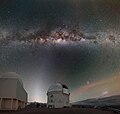
Size of this preview: 633 × 599 pixels. Other resolutions: 253 × 240 pixels | 507 × 480 pixels | 811 × 768 pixels | 1,081 × 1,024 pixels | 2,163 × 2,048 pixels | 7,000 × 6,629 pixels.
Original file (7,000 × 6,629 pixels, file size: 13.11 MB, MIME type: image/jpeg)
| This is a file from the Wikimedia Commons. Information from its description page there is shown below. Commons is a freely licensed media file repository. You can help. |
Summary
| DescriptionThe Colors of the Night Sky.jpg |
English: A remarkable array of colors is visible in the night sky over Cerro Tololo Inter-American Observatory (CTIO), a Program of NSF’s NOIRLab, in this image. We tend to assume that the night sky should be inky black and punctuated by stars, although it is rarely visible in cities and other highly-populated areas because of light pollution from artificial, man-made light. Interestingly, however, the night sky is not actually pitch black in the absence of light pollution. It instead reveals a beautiful array of subtle colors that arise from various phenomena. Most of the color in this image is due to red and green airglow, which is the term used to describe the slight brightening of the night sky caused by chemical reactions taking place in Earth’s atmosphere.
Español: En esta imagen se aprecia una increíble gama de colores en el cielo nocturno sobre el Observatorio Cerro Tololo (CTIO), un Programa de NOIRLab de NSF. Muchos creen que el cielo nocturno debería ser oscuro como la tinta y estar repleto de estrellas, pero debido a la contaminación lumínica causada por la luz artificial, rara vez podemos verlo así en las ciudades y otras zonas muy pobladas. Sin embargo, el cielo nocturno sin contaminación lumínica no es en realidad totalmente oscuro. Por el contrario, posee una hermosa gama de colores tenues causados por diversos fenómenos. La mayor parte del color de esta imagen se debe al airglow o luminiscencia nocturna roja y verde, que es el término utilizado para describir el ligero brillo del cielo nocturno causado por las reacciones químicas que ocurren en la atmósfera de la Tierra. |
| Date | |
| Source | https://noirlab.edu/public/images/iotw2226a/ |
| Author | CTIO/NOIRLab/NSF/AURA/B. Tafreshi |
Licensing
This media was created by the National Optical-Infrared Astronomy Research Laboratory (NOIRLab).
Their website states: "Unless specifically noted, the images, videos, and music distributed on the public NOIRLab website, along with the texts of press releases, announcements, images of the week and captions; are licensed under a Creative Commons Attribution 4.0 International License, and may on a non-exclusive basis be reproduced without fee provided the credit is clear and visible." To the uploader: You must provide a link (URL) to the original file and the authorship information if available. | |
This file is licensed under the Creative Commons Attribution 4.0 International license.
| |
Captions
Add a one-line explanation of what this file represents
Items portrayed in this file
depicts
6,400
image/jpeg
File history
Click on a date/time to view the file as it appeared at that time.
| Date/Time | Thumbnail | Dimensions | User | Comment | |
|---|---|---|---|---|---|
| current | 18:23, 22 June 2023 |  | 7,000 × 6,629 (13.11 MB) | C messier | full size |
| 19:57, 29 March 2023 |  | 1,280 × 1,212 (414 KB) | Yiseth Romero | Uploaded a work by CTIO/NOIRLab/NSF/AURA/B. Tafreshi from https://noirlab.edu/public/images/iotw2226a/ with UploadWizard |
File usage
No pages on the English Wikipedia use this file (pages on other projects are not listed).
Metadata
This file contains additional information, probably added from the digital camera or scanner used to create or digitize it.
If the file has been modified from its original state, some details may not fully reflect the modified file.
| Author | Babak Tafreshi |
|---|---|
| Copyright holder |
|
| ISO speed rating | 6,400 |
| Credit/Provider | CTIO/NOIRLab/NSF/AURA/B. Tafreshi |
| Source | NSF's NOIRLab |
| Online copyright statement | www.twanight.org |
| Image title |
|
| Short title |
|
| Usage terms |
|
| Date and time of data generation | 12:00, 29 June 2022 |
| JPEG file comment | A remarkable array of colors is visible in the night sky over Cerro Tololo Inter-American Observatory (CTIO), a Program of NSF’s NOIRLab, in this image. We tend to assume that the night sky should be inky black and punctuated by stars, although it is rarely visible in cities and other highly-populated areas because of light pollution from artificial, man-made light. Interestingly, however, the night sky is not actually pitch black in the absence of light pollution. It instead reveals a beautiful array of subtle colors that arise from various phenomena. Most of the color in this image is due to red and green airglow, which is the term used to describe the slight brightening of the night sky caused by chemical reactions taking place in Earth’s atmosphere. |
| Software used | Adobe Photoshop 23.0 (Windows) |
| File change date and time | 22:46, 5 December 2021 |
| Date and time of digitizing | 09:36, 18 July 2015 |
| Date metadata was last modified | 23:46, 5 December 2021 |
| Unique ID of original document | xmp.did:a9020e96-b0af-0a4a-aaed-124fc25bdcad |
| Copyright status | Copyrighted |
| Contact information |
950 North Cherry Ave. Tucson, AZ, 85719 USA |
| Country shown | Chile |
| Province or state shown | Elqui Valley |
| Sublocation of city shown | Cerro_Tololo_Inter-American_Observatory |
| IIM version | 4 |
Retrieved from "https://en.wikipedia.org/wiki/File:The_Colors_of_the_Night_Sky.jpg"
